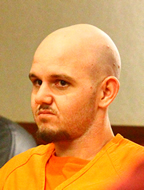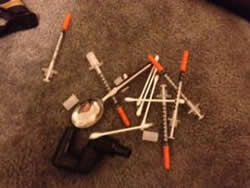Millennial Gangsters:
‘Money Over
Bitches’ vs.
Old School Street Values
by Scott Thomas Anderson
The Press Tribune

Mohammad “Young Dros” Noor when
he was arrested the first time for
heroin trafficking.
Two years ago, Mohammad “Young Dros” Noor was enjoying a reputation in his quiet California suburb as a heroin dealer with cash in his pockets, guns in his car and plenty of muscle to handle anyone who “snitched” him to law enforcement. He boasted a doctrine on social media that money came before everything in life; but after court testimony tied Noor’s alleged practice of lacing heroin to the death of a young man in Roseville, the self-proclaimed Norteno began to see his fortunes change.
Last month, Noor was sentenced to nearly a decade in state prison for witness intimidation, street terrorism and selling heroin.
Cases like Noor’s have some California detectives worried that the M.O.B. gang movement—or the Money Over Bitches proclamation—has filled a mentoring vacuum on the streets as experienced gang members continue to age in the state’s prison system.
Heroin was hitting hard in the area of Roseville, California, in 2013—located in the sixth wealthiest county in the state. In a six-month period, seven young people died of heroin or opiate overdoses, and more than double that number nearly expired en route to area hospitals. A small team of narcotics detectives in the Roseville Police Department tried to put a stop-gap in the body bags. Andy Palmore, one of the investigators, was having conversations with as many local heroin addicts as he could find. And one name began to surface. Young Dros.
“Most of the addicts were scared of him,” Palmore testified during a gang conspiracy case against Noor. “They thought he was dangerous.”

"White" Dane Fredrick
The fear factor on the streets came from Noor and three of his friends “clicking up” to suddenly indentify themselves as Nortenos. Noor’s crew, including George “Premo” Premock, “White” Dane Fredericks and Justine Crostino, began exchanging photos and messages on social media with regional gang members from the Northern Structure in Roseville, the A-Street Nortenos in North Highlands and North Side Nortenos in Sacramento County. The young people buying heroin from Noor quickly saw he was conversing with Nortenos on parole for armed robbery and a host of gun-related crimes. The message was clear about what could happen if an addict was arrested and “gave up” Noor.
According to court records, the investigation into “Young Dros” gained steam in May of 2013, when Noor and a man named Dereck Snider were pulled over by a California Highway Patrol officer. There was a “golf ball” sized lob of black tar heroin in the car, along with a digital scale and a loaded .38 caliber pistol. When Noor was released from jail, he began to suspect that Snider had told authorities the truth about who owned the gun. Noor got his hands on the CHP report and began sending photos of it to members of his crew.
“Yeeee, paper on deck,” Noor posted on his Facebook page, with a close-up photo of the line of the report indicating Snider had made a statement about Noor owning the pistol. “Fuck all you snitch-asses shitting on everything I love,” Noor added.
Palmore later explained the lingo to a judge on the witness stand. “It means there is paperwork, usually a police report, that supposedly proves someone from the drug world has been informing on others,” the detective testified.
Evidence presented in the hearing also showed Facebook messages from Noor’s crew suggesting there was a group consensus.
“Derek Snider snitchin’ fo sho,’” White Dane chimed in.
“Fuck Derek Snider, snitch bitch!” Corsino added.
“Premo” Premock alluded to Snider getting “killed” and said the addict was about to “come up missing.”

Roseville police detectives took this photo on a cell phone
during the spate of fatal heroin overdoses.
Detective Palmore discovered the witness intimidation when his team arrested Noor on new charges of trafficking heroin. At that moment, the police department had just stood over the bodies of three dead addicts from overdoses, and watched six more rushed off to hospitals with near-fatal heart stoppages. Cell phones seized from Noor and his crew began to raise questions about what was happening.
“Detective Palmore, do you know of a person named Adam Parker?” Placer County prosecutor Jeff Moore asked during the hearing in Noor’s case.
“Yes,” Palmore said.
“Is Mr. Parker alive?”
“No,” the detective replied. “Mr. Parker is dead.”
The prosecutor had a quick response when Noor’s attorney objected.
“I think it’s extremely relevant to establishing a motive for making the threats as it pertains to Mr. Noor,” Moore argued. “Mr. Noor has so much to lose if he’s outed as a heroin dealer and one of his (customers) just died of an overdose.”
The next question for the detective revealed that Parker and Snider had been best friends.
“Snider told me Parker obtained his heroin from Mr. Noor,” Palmore testified.
“Did Mr. Snider say he had personal knowledge of whether Mr. Noor was cutting his heroin with propofol?” Moore asked.
“Mr. Snider said he was familiar with heroin cut with propofol, and that the heroin Noor was selling was consistent with that, since it was wetter than normal heroin,” the investigator responded. “He also said Mr. Noor doesn’t tell anyone his heroin is cut … when we first arrested Noor, he did have heroin of two different consistencies—and one was far wetter than the other.”
A toxicology report on Parker’s body later confirmed he died of a massive heroin overdose. Whether the opiate substance was cut with a secondary drug is less clear.
But if addicts in Roseville were figuring out Noor’s crew was lacing their heroin, the chances of a confrontation or turning to the police were slim. Noor, Corsino, “Premo” and White Dane were rolling through the city in Norteno colors.
Photographic evidence presented at Noor’s hearing showed “Premo” posing with a 9mm and taking close-up photos of an AK-47.

This toilet filled with dirty needles greeted Roseville
detectives during the three month period when local
young people were dying of fatal heroin overdoses.
During one of Noor’s court dates, Roseville police detective Mike Ryland was called to testify as his department’s main gang expert. Ryland asserted that a deluge of photos and social media postings from Noor’s crew proved they were not only claiming to be Nortenos, but they were also publicly flashing a very specific philosophy known as M.O.B.—a kind of mission statement being adopted by some gangs in California.
“What are the three Rs traditionally found in gang culture?” the prosecutor asked Ryland.
“Reputation, respect and revenge,” he answered. “It’s a general code most gangs operate by.”
“Recently, have you seen a shift in Roseville from the three Rs to a different kind of gang culture?” Moore continued.
“Yeah,” Ryland answered. “Recently a lot of the gangs are associating with a philosophy called Money Over Bitches, or Money Over Broke-ass bitches. It’s basically a commitment that money is going to come first, before anything else … A lot of the older Nortenos in Roseville are in jail or prison right now. There’s not a lot of leadership or mentoring for young guys who are getting involved with it.”
The FBI reports tracking the M.O.B. creed’s emergence with gangs from Los Angeles and Las Vegas to Chicago and Boston since at least 2003. Several murder cases from the last two years have been directly related to M.O.B.-influenced gang personalities. Local and national law enforcement experts also agree the reason most heroin dealers cut their product with propofol is to make a small supply spread a long way, hence maximizing the profits.
Last week, on the verge of going before a jury, Noor pleaded guilty to a host of criminal charges, including street terrorism, threatening a witness with force, conspiracy to dissuade a witness, inducing false testimony, selling heroin and committing a felony while on bail for a felony. He was sentenced to 9 years in state prison.
